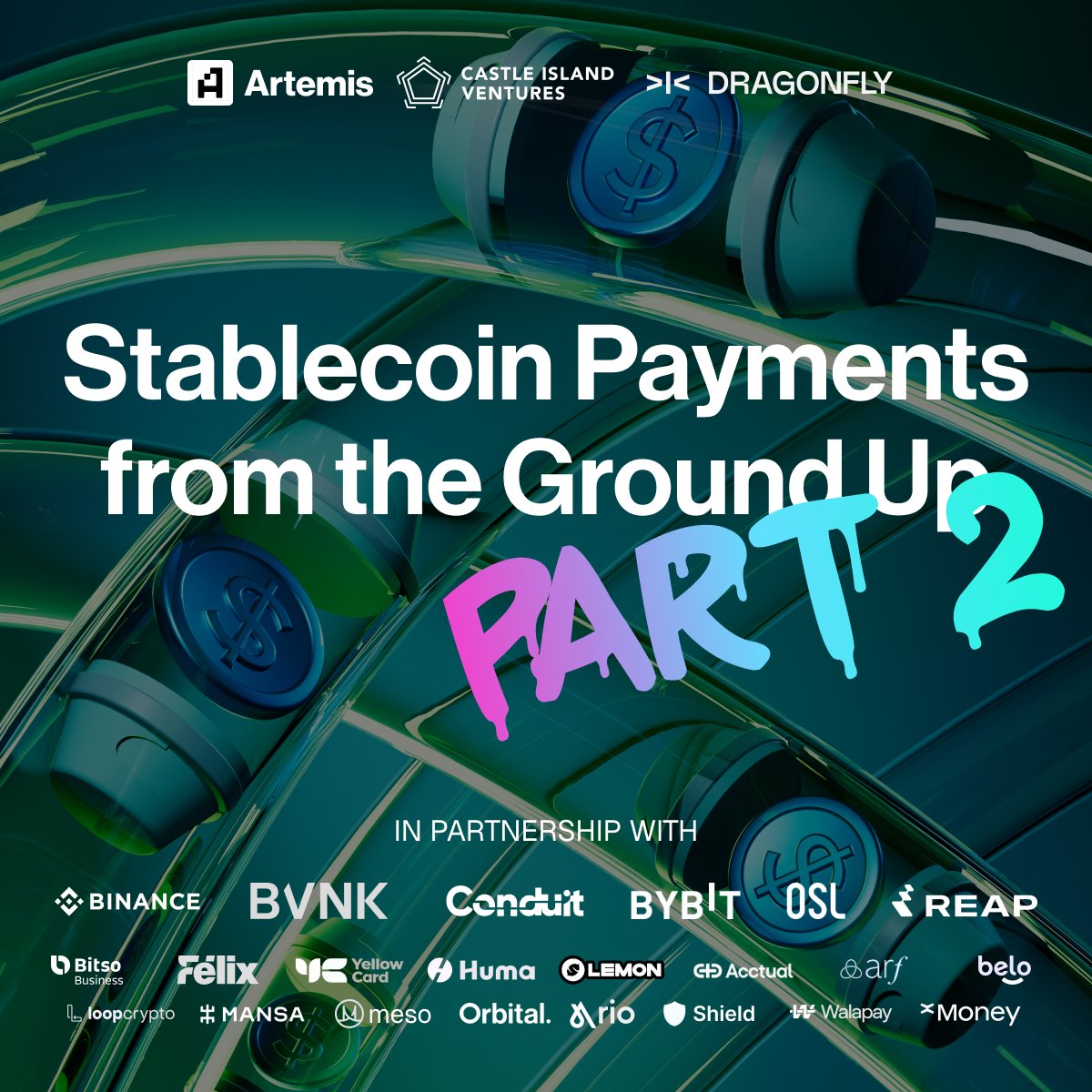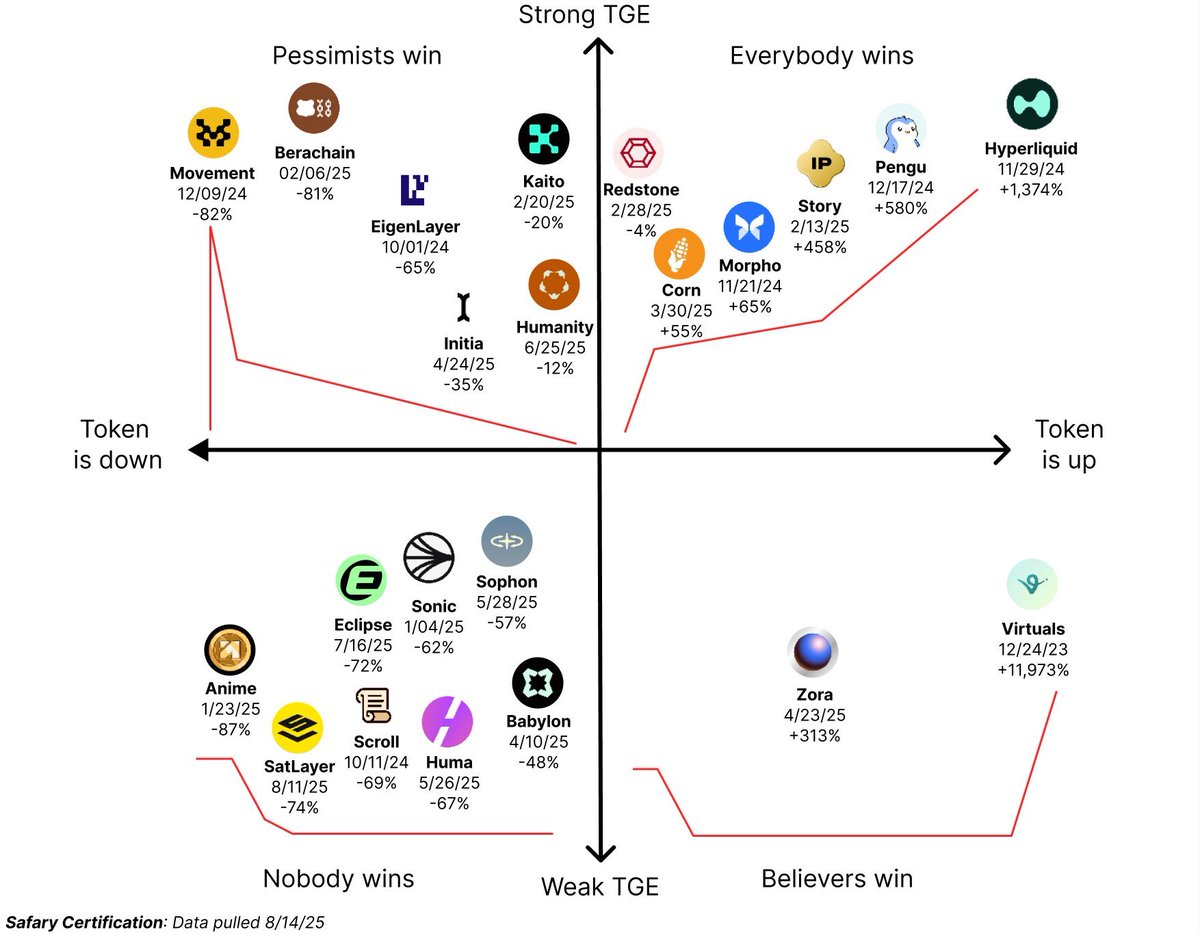One of the underappreciated secrets to winning in any new sector is: just stick around.
If you just stick around long enough, the losers blow up early. Then the winners retire early. So eventually you win by just doing the work when nobody else can or wants to.
When people ask me how we built Dragonfly to became one of the biggest VCs in crypto, this is mostly the answer. We didn’t start with a big brand or any obvious advantages. Few people in the crypto world knew who I was before Dragonfly.
But we just kept doing the work. While others got too rich and retired, or just got bored or distracted, we kept doing the work. For 7 years.
It’s kind of that simple.
(This insight shamelessly stolen from @naval)
The @doublezero network's fees went live in early October, here's a snapshot for the month so far: ~$256,000 of USD equivalent fees.
According to @DefiLlama this puts DoubleZero at 16th in 30-day fees-by-network less than a month since launch.
These fees go to contributors of
Gave a lightning talk at the @ThetaInvest conference: 8 charts showing why stablecoins are eating the world, all in 10 minutes.
If you know any stablecoins skeptics and you want them to get the big picture view of why this is such a big deal, send them this 👇
We @1kxnetwork just released the most extensive report on monetization of the crypto industry to date:
The 1kx Onchain Revenue Report (H1 '25) aggregates verified onchain fee data across 1,200+ protocols - mapping where users pay, how value flows, and which sectors are driving
People sometimes ask why more VCs don't call out founders leaving their high-flying startups.
The answer is because: I've seen enough of these behind the scenes, and almost always there's more to the story.
Founders very rarely willingly leave a startup that's working. The founded the damn thing. It's their baby—it's their whole identity. They got into startups in the first place because they want to brag about it and have it go on their epitaph: "Joe built and scaled $startup."
Almost always they are not "exit scamming." There was a power struggle, someone got pushed out, or they had a health issue and were asked to step aside, or was just a terrible leader and there was a mutiny.
Founders don't get "bored" and exit a project that's working. That's what they live for. It is extremely compelling to be at the helm of something that's taking off. You grind for years to have that opportunity, and if you're then forced to walk the plank by your teammates, it's a soul-crushing experience. That's often what's happening to these founders when they're posting how "grateful they are for their amazing journey."
So that's why I don't criticize founders leaving companies. Unless you're close to it, you don't know the story. But usually the answer is bloody, and the company is better off now that it's over.
I don't know the Story team and I don't know Jason, so to be clear—I don't know shit. But I will say, next time you see a founder leaving a high-flying startup, consider leaving the pitchfork in the shed.
People sometimes ask why more VCs don't call out founders leaving their high-flying startups.
The answer is because: I've seen enough of these behind the scenes, and almost always there's more to the story.
Founders very rarely willingly leave a startup that's working. The founded the damn thing. It's their baby—it's their whole identity. They got into startups in the first place because they want to brag about it and have it go on their epitaph: "Joe built and scaled $startup."
Almost always they are not "exit scamming." There was a power struggle, someone got pushed out, or they had a health issue and were asked to step aside, or was just a terrible leader and there was a mutiny.
Founders don't get "bored" and exit a project that's working. They what they live for. It is extremely compelling to be at the helm of something that's taking off. You grind for years to have that opportunity, and if you're then forced to walk the plank by your teammates, it's a soul-crushing experience. That's often what's happening to these founders when they're posting how "grateful they are for their amazing journey."
So that's why I don't criticize founders leaving companies. Unless you're close to it, you don't know the story. But usually the answer is bloody, and the company is better off now that it's over.
I don't know the Story team and I don't know Jason, so to be clear—I don't know shit. But I will say, next time you see a founder leaving a high-flying startup, consider leaving the pitchfork in the shed.
Solana daily active addresses are now down 60% from ATH at the end of 2024, according to @artemis
Left: daily active addresses on Solana (7.5M => 3M)
Right: daily active addresses on Pump (420K => 120K)
Memecoin mania has now perhaps cooled into steady state. It's not going away, but it's also not all-encompassing anymore.


Good VCs are not "nice."
Good VCs are high-integrity. They're dependable partners. But they're not "nice." If you have a bad idea, they'll tell you why it's bad. If you fuck your pitch, they'll tell you what you fucked up. If a founder's screwing up their company or being unrealistic, they'll call it out and tell them what no one else is willing to say to their face. If there's bad behavior in the industry, they'll say something about it and try to change it.
Every great investor I can think of in this industry, I would not describe them as "nice."
"Nice" VCs just try to stay quiet, squeeze into deals, and not rock the boat. Nobody objects to them, but they don't win deals, and they're not the people you want to work with when the going gets tough.
We don't need more "nice" VCs.
"We believe NEAR presents the greatest asymmetric upside across mature projects in the digital asset market, which we aim to capture and offer to our shareholders" - OceanPal's Co-CEO, @sal_ternullo
We are excited to be working with the @svrn_ai team.
Congrats to ZAR on raising a new round led by a16z!
ZAR is building a merchant network for the global south (starting in Pakistan) to get access to stablecoin-based payments, remittances, and cards. So much about payments in the old world is broken, and ZAR uses crypto rails to directly improve the financial plumbing in these places.
Super proud to be partnered with them.
Who has the best argument of why equity perps are superior to CFDs?
Would love to hear the other side of this.
New favorite podcast is @MargRev podcast by @tylercowen and @ATabarrok. Highly recommended. Two of the most influential economists debating the big ideas in economics—how much does the Fed actually matter? What explains the rising cost of education/healthcare/services? What actually caused the 1970s crime wave?
Gets wonky, but my favorite podcasts are experts just talking genuinely to each other.
https://t.co/NJIRpGRnNr
Just dropped a massive stablecoin report—headline, stablecoin payments volumes have increased by 70% _since February_.
Driven in part by B2B market, up 113% in the same period. And @circle picking up market share!
Check out the report, goes super deep w/ proprietary data👇

Three takeaways from my post about wealth/technology yesterday:
1) People are really, really triggered by any suggestion that technology is has been a massive force equalizer. They are very committed to the idea that billionaires live radically different lives from them, and that technology is an opiate used to distract them from this.
2) Many have cartoonish ideas about how the wealthy spend their time. They believe wealthy people are mostly partying in yachts and jetting to the Maldives every weekend. Turns out, wealthy people are mostly workaholics—that's why they're wealthy (~70% of US billionaires are self-made), and you can't build a company while constantly on vacation.
3) People have really no sense about how the lived experiences of humans, across every decile of wealth, has dramatically improved over the last 100 years. Many people somehow seem to believe that the world was better in 1950—which could not possibly be more wrong. This trend is true across poverty, crime rates, life expectancy, education, pretty much anything you can measure.
I think Warren Buffett stated it best (h/t @jillrgunter):
"Money makes very little difference after a moderate level. I tell this to college students. They are basically living about the same life I'm living. We eat the same foods — that I can guarantee you. There's no important difference in our dress. No important difference in the television set that we watch the Super Bowl on... Almost everything of importance in daily life, we equate on."




@hosseeb “Money makes very little difference after a moderate level. I tell this to college students. They are basically living about the same life I'm living. We eat the same foods — that I can guarantee you. There's no important difference in our dress. No important difference in the
So many people on here obsess about wealth, but it's worth remembering that billionaires live mostly the same way you do. Technology has collapsed the experiential divide.
Rich people use the same LLMs you do. They watch the same Netflix shows, the same movies, the same sports. They are addicted to their phones just like you are, and they browse the same stuff on social media. There's no special Internet for rich people.
IMO, the gap between the middle class and the 0.01% is the smallest it's ever been.
We bring on Mad Dog @0xMert_ to talk Zcash and why the BTC community is up in arms.
Meanwhile, Tempo raised $500M, Dankrad and Szilagyi defected from the EF, and an AWS outage took down Base's sequencer (wtf?)
Plus, Mert breaks down why a Solana stablecoin might be doomed ⤵️
zcash up 5x and suddenly everyone’s a privacy expert.
@0xMert_ joins to discuss:
🤑 Tempo’s ~$5B val; Dankrad exit
⚖️ public-goods vs profit
🔌 AWS/Base outage
Timestamps
00:00 Intro
01:22 Mert: Madman of Solana & Now Zcash
05:20 Bitcoin vs. Zcash: A Philosophical Clash
14:35
really liked @hosseeb reflections on Ethereum culture in this pod. small AI summary but do check out the ep:
'Upholding Civil Society: Haseeb argues that there are different spheres—like government, church, or a public goods foundation—that operate by different rules than the
We bring on Mad Dog @0xMert_ to talk Zcash and why the BTC community is up in arms.
Meanwhile, Tempo raised $500M, Dankrad and Szilagyi defected from the EF, and an AWS outage took down Base's sequencer (wtf?)
Plus, Mert breaks down why a Solana stablecoin might be doomed ⤵️
This makes no sense. The data here does not tell a clear story.
OP tries to claim that "Big bang TGEs are dead," but half of the "Strong TGEs" are up, half of them are down. And by proportion, most of the successful tokens are "Strong TGEs."
And then the bottom left quadrant of "weak TGEs" only has 8 entries in it, when it should have more like 1000 entries—most TGEs are weak and have negligible hype. That makes it more obvious that Zora and Virtuals are outliers, which is not a strategy.
There is no simple story to tell about how to launch a successful token. Definitely nothing that fits on a Hallmark card. "Launch small and accrue value over time" is another way of saying, "be a sleeper hit," which is not actionable advice.
If people are excited about your token, you cannot launch low. That is a fantasy. If you launch Monad at $500M, it will pop up to multi-billion valuation the next block. You're just giving away money to snipers. It's no different from memecoin launches or NFT mints. If the market believes you're worth X, you're gonna be priced at X, like it or not.
But while I disagree with the analysis of OP, the vibe is clearly dead-on. The rotation of hot money out of the altcoin market and into the equity market over 2025 has challenged a lot of TGEs. But I tend to think these things are all cyclical. People have short memories in crypto, but I remember many points in past cycles where alts were weak, and every time people tell themselves "well that's it, it's finally over, alts will never again catch a bid."
I don't worry too much about that.
But in the meantime, entrepreneurs have to keep building, cycle in, cycle out. My advice to them: focus on product, retain your team, treat your community well, and don't mistake your token price as your report card. Remember what you're building and why you're building it, and trust that if you build something that your users love, the market will ultimately reward you.
Just might take longer than you once thought.
This is interesting. I once thought of open source as a computing philosophy, but maybe that's an outdated view. China has increasingly realized that it's just a better business strategy as a technological challenger.
Beyond Deepseek and Qwen, China built the dominant quadruped robot, @UnitreeRobotics, which has open SDKs compared to its western closed counterparts. Unitree has ~70% market share in Quadrupeds globally, and they dominate in the research community because they're cheap and easy to write code for.
By comparison, @BostonDynamics you have to pay an annual fee to have that degree of low-level control.


So after the earlier delisting drama, @Aster_DEX is now back on @DefiLlama but with big gaps in their historical data.
Doesn't seem like the re-listing was ever publicly discussed... are we good now? Satisfied volume numbers are legit @0xngmi?

Seasonality in prediction markets:
@Polymarket (blue) has had more volume than @Kalshi (green) on almost every day except Sundays and Mondays because of—you guessed it—sports. Biggest games are on Sundays & Mondays, hence this pattern. Most of Kalshi's volume is sports (>80%), coming through their Robinhood integration which started earlier this year.
Recently Polymarket has been picking up more sports volume. But merely looking at weekly volume numbers/market share hides the more obvious pattern.
Always look at your data!

Seasonality in prediction markets:
@Polymarket (blue) has had more volume than @Kalshi (green) on almost every day except Sundays and Mondays because of—you guessed it—sports. Biggest games are on Sundays & Mondays, hence this pattern. Most of Kalshi's sports volume comes through their Robinhood integration which started earlier this year.
Recently Polymarket has been picking up more sports volume. But merely looking at weekly volume numbers/market share hides the more obvious pattern.
Always look at your data!

Prediction markets are supposed to give you probabilities, not outcomes. The real world is uncertain, and @Polymarket quantifies that uncertainty with probabilities.
So if it's not "Polymarket predicted X and X did/didn't happened"—if it just outputs probabilities—how do you measure how predictive Polymarket actually is?
Statisticians already have a tool for this, called the Brier Score. Brier Scores basically tell you: "when you say an outcome is ~60% likely to happen, do those things happen 60% of the time?" Same for 10%, same for 90%, and so on.
Here's what that looks like for Polymarket, @Dune dashboard by @alexmccullaaa 👇
For Brier Scores, smaller is better. Anything below 0.1 is generally fantastic. (Sports betting lines tend to be around 0.2). Polymarket's Brier Score is 0.056, which means it is extremely accurate at surfacing correct probabilities.
Takeaway: Polymarket is very accurate, but it's subtle what that means and how it's measured.
































